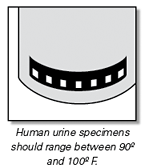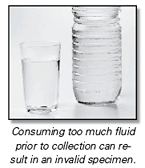Specimen Collection
Specimen tampering & verification
Principle
 Methods to adulterate urine samples for substance abuse testing generally fall into three categories; 1) urine substitution; 2) ingestion of fluids or compounds for flushing out the system, diluting the sample, or interfering with the testing process; or 3) direct addition of adulterants to the urine specimen itself. The substitution of one's own urine sample with one which is clean is a common practice. The best means to combat this practice is to measure urine temperature, as urine specimens even held close to the body for extended periods of time will not produce a physiologically temperature-correct specimen. However, practices of reverse catheterization with clean urine and placement of urine filled balloons in the vaginal cavity can produce urines of correct temperature.
Methods to adulterate urine samples for substance abuse testing generally fall into three categories; 1) urine substitution; 2) ingestion of fluids or compounds for flushing out the system, diluting the sample, or interfering with the testing process; or 3) direct addition of adulterants to the urine specimen itself. The substitution of one's own urine sample with one which is clean is a common practice. The best means to combat this practice is to measure urine temperature, as urine specimens even held close to the body for extended periods of time will not produce a physiologically temperature-correct specimen. However, practices of reverse catheterization with clean urine and placement of urine filled balloons in the vaginal cavity can produce urines of correct temperature.
Drinking large volumes of liquid, especially cranberry juice or vinegar is common practice. However, studies demonstrate these practices have no effect on testing methodologies and may present unexpected results.
 Many of the drugs being tested are pH dependent. When large volumes of cranberry juice or vinegar are consumed, the urine pH is lowered, and the excretion rate of these drugs may increase. If timed correctly, large amounts of a drug may appear sooner in the sample.
Many of the drugs being tested are pH dependent. When large volumes of cranberry juice or vinegar are consumed, the urine pH is lowered, and the excretion rate of these drugs may increase. If timed correctly, large amounts of a drug may appear sooner in the sample.
Be aware, drinking large volumes of vinegar can be toxic.
One potentially effective method which may negatively impact the testing process is to consume large volumes of water, as short term water loading can increase urine volume up to eight fold. Therefore, if the individual's drug concentration is near the cutoff of an assay, the urine may be diluted enough so that the sample will test below the cutoff level. Other attempted methods of adulteration include ingesting large amounts of vitamin C, vitamin B, niacin, Golden Seal, etc. All of these practices are ineffective.
Adulteration of a urine sample with various chemicals is shown (in the literature) to inactivate some of the laboratory testing methodologies, most notably, the enzyme immunoassay's. Addition of compounds such as sodium chloride, sodium bicarbonate, hydrogen peroxide, bleach, alcohols, blood, various soaps, etc. are shown to produce both false negatives and false positives.
The current list of urine adulterants is ever changing as the Internet provides an informational source, as well as a retail outlet for commercial products capable of affecting the outcome of some urine drug testing methodologies. Currently, nitrites (Klear and Whizzies) are adulterating agents commonly found in the industry. RTL is capable of providing testing for these agents.
Adulteration Detection
Means to detect adulteration by the collector and/or the laboratory include the following:
-
Specimen Temperature: If specimen collection is not witnessed, the most effective means to detect specimen dilution, adulteration, or substitution is to measure the sample's temperature. The collector should measure the temperature utilizing the temperature strip affixed to the specimen container within four minutes of collection; it should read between 90 and 100 degrees Fahrenheit. The urine temperature should be noted on Urine Test Request form.
-
Urine Appearance and Odor: Adulterants such as isopropyl alcohol, soaps, bleach and perfumes are readily identified by their odor. Soaps are also identified by excessive bubbling. Use of solid adulterants is detected by the presence of residues in the container.
-
Creatinine: In general, creatinine is a metabolic byproduct of muscle metabolism which normally appears in urine in relatively constant quantities over each 24 hour period. Therefore, urine creatinine can be used both as a marker to specifically identify a specimen as urine, and as an indicator of urine water content (dilution). "Normal" random urine specimens will generally have urine creatinine levels of greater than 20 mg/dL, while specimens with creatinine levels between 10 and 20 mg/dL may be due to increased liquid consumption, dietary habits, or liquid ingestion preferences. Urine specimens with creatinine levels between 2 and 10 mg/dL are usually a result of ingestion of large volumes of water (or other liquid), termed short term water loading. This is a very common practice when attempting to dilute a urine so that any drugs in the urine will be diluted below analytical testing cutoff levels. Urine creatinine levels below 2.0 mg/dL indicate the specimen is not consistent with human urine.
Urine specimens become dilute as a result of the short term consumption of large amounts of a liquid due to an unknown stimulus such as a response to heat or exercise, herbal flushes, prescription diuretics, intentional dilution, or pathological situations such as diabetes insipidus. The dilution effect from consuming increased volumes of liquid can last from 2 - 5 hours. Therefore, the increased consumption of liquid would have to take place between 2 - 5 hours prior to the collection of the urine specimens.
An important factor to consider when interpreting dilute urine samples is that drug use can never be assumed unless specifically detected, and confirmed in a urine sample. Certainly, a dilute sample can produce false negative results, as drugs in the urine at concentrations near the testing cutoff may be diluted below the testing cutoff level, however, due to the reasons stated above it can be difficult to establish the reason or intent for the sample(s) being dilute. For these reasons, urine creatinine is reported in conjunction with testing for drugs of abuse, as an indicator of specimen validity only, as urine specimens with a creatinine level below 20 mg/dL may have an increased likelihood of producing a false negative drug testing result.
-
Specific Gravity: Normally, a random urine specimen will have a specific gravity of between 1.003 and 1.035*. An extremely low specific gravity (<1.003) indicates a dilute specimen, while abnormally high specific gravity (>1.045) may indicate the presence of dissolved solids such as sodium chloride and sodium bicarbonate.
-
pH: Reference Range = 3–11. Urine specimens with a pH outside of this range strongly suggests the specimen has been adulterated.
-
Visible Blood: Indicates the presence of blood in the urine specimen. The presence of blood in the urine sample may adversely impact the testing process and, in addition, constitutes a biohazard for laboratory employees. Collection of clean catch urine specimens during menstruation should be attempted.
Urine adulteration is a double edged sword as both false negative and false positive results can occur. However, most adulteration attempts can be detected by either trained collection site personnel or by collection procedures as outlined above. Coordination and cooperation between the collection site and the testing laboratory provide effective and reliable drugs of abuse testing.
*NOTE: Normal ranges are indicated for freshly voided urines only.